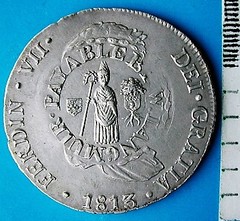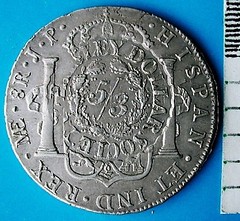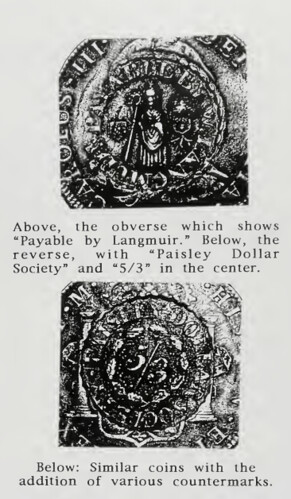
PREV ARTICLE
NEXT ARTICLE
FULL ISSUE
PREV FULL ISSUE
1804 WILLIAM LANGMUIR COUNTERMARK SOUGHT
Pat McBride of the Pennsylvania Association of Numismatists (PAN) forwarded this inquiry from researcher Eric Hodge who is seeking an
image of an 8 reales countermarked by Scottish merchant W Langmuir. Can anyone help? His inquiry was spurred by his searches in the
Newman Numismatic Portal. -Editor
Eric Hodge (writing to PAN): Clarion magazine Vol. 23 number 1, Mar/Apr 2006 pages 8-9 Unique Discovery. Dear Sir/Madam. I live in the UK and am an amateur numismatist specialising in UK merchant countermarked silver coins from the period 1780 to 1830. Since the death last year of Harry Manville I have tried to continue his work in this area. I have just seen the above magazine and the article refers to a countermarked 8 reales for W Langmuir of Paisley in Scotland. The article was written by Dr. Henry Stouffer and he states he has an 1804 8 reales with this countermark. If possible I would like to obtain photographs of this coin. Do you know Dr. Stouffer? Is it possible to trace him or his coin collection? Thank you for any advice or help you can give me. Yours Faithfully. Eric Hodge. Pat McBride writes: Dr. Stouffer no longer owns the 1804 piece and can’t recall where it is now. E-Sylum readers my be able to track down more information and help Eric.
So... does anyone know the present whereabouts of this coin? Or where to find an image of it? Below is the text of Stouffer's article
and its images of similar pieces. -Editor
Unique Discovery
I'm sure that many of you have been delighted to have come across a coin, medal or token that has spurred a great deal of research and investigation. In my 57 years in the hobby, I've been quite fortunate, having found the fifth known “ugly head” Washington medal, as well as several rare large cents. However, the subject of this story, concerning an eight reale piece dated 1804, had an amazing conclusion. The subject coin came into my hands about a year and a half ago. The first thing I noticed was heavy counterstamping — not only on the obverse, but also on the reverse. Our friend Charles (Carolus) the 4th was pretty much obliterated on the obverse, with the legend, “Payable by W. Langmuir” and some kind of interior design. But most interesting was a heavy grill-like counterstamp on the reverse, with the legend “Paisley Dollar Society,” with the numeral “50” centered on it. This covered about 60 percent of the reverse. The Search
Q. David Bowers
Russ Rulau
Gregory Brunk
Harrington Manville
At the right are photos of coins of this type — the upper ones showing the Langmuir/Paisley Dollar as it was issued, and below, showing it with countermarks. Now, to the amazing conclusion. I was given a listing of the known dated specimens, and recognizing that the U.S. 1804 Dollar is numismatically famous, it turns out that our specimen is the first known — and only one with the date of 1804. How about that !
Eric is a new E-Sylum subscriber and he kindly provided these images of an uncancelled Langmuir. Thanks. -Editor
 
To read the complete Clarion issue, see:

Wayne Homren, Editor The Numismatic Bibliomania Society is a non-profit organization promoting numismatic literature. See our web site at coinbooks.org. To submit items for publication in The E-Sylum, write to the Editor at this address: whomren@gmail.com To subscribe go to: https://my.binhost.com/lists/listinfo/esylum All Rights Reserved. NBS Home Page Contact the NBS webmaster 
|
